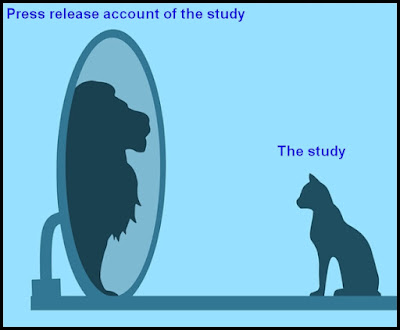A significant fraction of the neuroscience news these days contains exaggerations, extremely dubious interpretations or downright falsehoods. Sometimes these falsehoods are so brazen that they must be branded as fake news. An outrageous example of fake news was a recent story in the British new source The Independent, a story with the phony headline, "Brain scan reveals patient’s ‘last thoughts’ just before they died in landmark study." Below are some of the reasons the headline and the story are as phony as a three-dollar bill:
- The scientific study made no claim to have revealed the thoughts of the dying 87-year-old patient, nor did it even make any guess about such a thing.
- No one is quoted in the article referring to last thoughts.
- The headline uses the phrase "just before they died," suggesting there were multiple patients involved in the new study; but there was only one patient.
- The patient did not actually have his brain scanned as he died. Brain scans are done with MRI machines, and the patient was not being scanned in an MRI machine or any similar machine when he died. Instead, there was a merely a reading of electrical activity by means of EEG electrodes.
- There was nothing "landmark" about the study, as there have been electrode readings of the brain activity of numerous previous patients as they died. The subtitle of the story makes the untrue claim that there were "first-of-a-kind brain scans," when nothing "first-of-a-kind" was done, and no brain scan was done.
- As discussed below, there are very strong reasons for assuming that the patient in question was unconscious in the moments before death, and that he therefore was not thinking about anything just before dying.
We don't need to read very far to find out how phony the story is. The headline claims "brain scan reveals patients 'last thoughts,'" but the subtitle states this: "First-of-a-kind brain scans of dying person indicate they may have been making ‘last recall of life’, scientists say." So the headline and the subtitle contradict each other. If scientists were merely speculating that the patient may have been recalling his life, then nothing has been actually revealed about what the patient was thinking. Of course, the idea that you can figure out someone's thoughts by looking at EEG readings is as nonsensical as the claim that you can find out someone's future life events by reading lines on his palms. EEG readings are mere squiggly lines without any semantic content.
The untrue "first-of-a-kind" claim is partially the fault of the Frontiers press release, which made this untrue claim: "This unexpected event allowed the scientists to record the activity of a dying human brain for the first time ever." You can very easily find out how untrue this claim is by using a Google search phrase of "EEG reading of dying patient," and using the Tools option to restrict the search results to be from 1/1/1990 to 1/1/2021. In your search results you will get papers such as the 2017 paper "Electroencephalographic Recordings During Withdrawal of Life-Sustaining Therapy Until 30 Minutes After Declaration of Death," and this 2017 press article about the study (which shows some of the EEG readings from four dying patients).
Besides making the untrue claim above, the Frontiers press release is guilty of getting the ball rolling on this fake news story, by suggesting the utterly groundless idea that the EEG readings from a seizure-wracked dying patient in a coma did something to suggest the patient was recalling events in his life. Here is a quote from the press release:
" 'We measured 900 seconds of brain activity around the time of death and set a specific focus to investigate what happened in the 30 seconds before and after the heart stopped beating,' said Dr Ajmal Zemmar, a neurosurgeon at the University of Louisville, US, who organised the study. 'Just before and after the heart stopped working, we saw changes in a specific band of neural oscillations, so-called gamma oscillations, but also in others such as delta, theta, alpha and beta oscillations.' Brain oscillations (more commonly known as ‘brain waves’) are patterns of rhythmic brain activity normally present in living human brains. The different types of oscillations, including gamma, are involved in high-cognitive functions, such as concentrating, dreaming, meditation, memory retrieval, information processing, and conscious perception, just like those associated with memory flashbacks. 'Through generating oscillations involved in memory retrieval, the brain may be playing a last recall of important life events just before we die, similar to the ones reported in near-death experiences,' Zemmar speculated. "
Notice the nonsense reasoning here. It's basically this:
(1) People have different types of brain waves, which occur when they do various things like thinking, recalling, meditating (which does not involve recall), and perceiving.
(2) Some brain waves were measured in a person who died.
(3) So maybe he was recalling important life events.
This is nonsensical logic. The study has not provided the slightest reason for thinking that the dying person was remembering past events in his life. To the contrary, we can think of the strongest reason why a person would not be recalling important life events after having a sudden heart attack. The sudden heart attack would produce great pain and great distress, and under such conditions if you were conscious you would be no more likely to be recalling past life events than you would be if someone suddenly stabbed you in the chest. In fact, sudden fatal heart attacks instantly produce unconsciousness which should prevent anyone from engaging in thinking about past events.
The scientific paper describes the patient's condition before death, and we learn of a state so dire that any speculation about the patient reliving past memories seems supremely absurd. We are told the patient was a 87-year-old who had suffered a fall, and who was in a coma (rating 10 on the Glascow Coma Scale, meaning a moderate coma). Here is how the paper describes the patient's death.
"An electroencephalography (EEG) was obtained, which showed non-convulsive status epilepticus in the left hemisphere. There were at least 12 identified electrographic seizures, after which a burst suppression pattern spontaneously developed over the left hemisphere (Figure 2A). Shortly thereafter, electrographic activity over both hemispheres demonstrated a burst suppression pattern, which was followed by development of ventricular tachycardia with apneustic respirations and clinical cardiorespiratory arrest. After discussion with the patient’s family and in consideration of the 'Do-Not-Resiscitate (DNR)' status of the patient, no further treatment was administered and the patient passed away."
Given such a patient state, it is obvious folly to be speculating that such a patient was reliving past memories just before death. Status epilepticus is a life-threatening seizure of particularly long length. Apneustic respirations are a kind of gasping suggesting death is very near. Twelve seizures would have produced a "witch's brew" of brain signals showing up on EEG readings, and from such a thunderstorm of brain signals nothing reliable can be inferred about what a patient was thinking or recalling. Since the patient was in a coma and plagued by a dozen seizures that disrupt mental processes such as recollection if it is occurring, it makes no sense at all to speculate that the patient was thinking about or recollecting anything.
Giving us a headline as phony as the headline quoted above from the Independent, the Daily Mail gives us this fake news headline about this patient: "Our lives really DO flash before us: Scientists record the brain activity of an 87-year-old man at the moment he died, revealing a rapid 'memory retrieval' process." This headline is as phony as a three-dollar bill. Zero evidence has been provided in the scientific paper of any memory retrieval around the time of death, and the patient's condition gives the strongest reason for disbelieving that any such thing was occurring. A similar fake news headline occurs on www.bbc.com, showing that once an expert lights a fake news match, the fake news fire will spread even to sources the average person regards as having high journalistic standards.
There is an abundance of reliable evidence that people have extraordinary near-death experiences after their hearts have stopped. Such experiences often include what are called life-review experiences, in which a person may recall important moments from his life. Neuroscience has done nothing to explain such near-death experiences.
The fact of such experiences is a major reason for rejecting all claims that human consciousness is a product of the brain, and that memories are stored in brains. According to such claims, no one should have any mental experiences at all other than unconsciousness after his heart stops. Within a few seconds after a heart stops, a brain shuts down its electrical activity. This was shown by the 2017 paper I previously mentioned, "Electroencephalographic Recordings During Withdrawal of Life-Sustaining Therapy Until 30 Minutes After Declaration of Death," Figure 1 of that paper shows EEG readings of four patients for thirty minutes after their hearts stopped. The readings are flat lines, except for three or four little blips that can be compared to momentary muscle twitches of a corpse a few minutes after death. The Zemmar study does nothing to challenge ideas that brains promptly shut down as soon as a heart stops.
On the same day that we had the fake news headlines quoted above, we had another fake news headline, one that declared, "New project creates digital clones of human brains to help treat neurological disorders." No one has created any such thing as a digital clone of the human brain. We can also be quite confident that no one ever will do such a thing, because the act of measuring all of the synapse states and neuron states of a brain would inevitably kill a person, or require the cutting away of so much tissue that you would never be left with a clone of the person's original brain state. In the text of the story we read that the work being done is merely the creation of some "virtual model," something not at all a clone of the brain.




